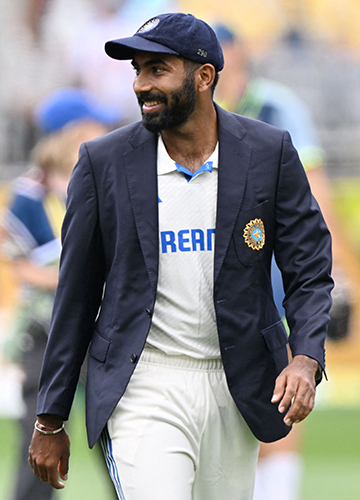INDIA’S 295-RUN VICTORY in the first Test in Perth left not just the Aussies, but also the entire cricket world in disbelief. Bundled out for 150 in the first innings on a fiery pitch, India looked to be down for the count. How soon India would lose and by what margin were the major points of debate at that stage.
What transpired thereafter makes for one of the most melodramatic stories in Test cricket history, as India turned the match on its head in a remarkable display of self-belief and fantastic all-round skills.
Spanking centuries by Yashasvi Jaiswal and Virat Kohli, sublime batting at the top by K.L. Rahul, telling all-round performances by young Washington Sundar and Nitish Kumar Reddy, and feisty pace bowling by Mohammed Siraj and Harshit Rana were stellar contributions to India’s triumph. But none of these was as significant and eye-catching as Jasprit Bumrah’s tour de force performance.
As captain, he led from the front, showing guts and imagination. The manner in which he marshalled the bowling―the changes he rang in and the fields he set―allowed the Aussie batters no respite. But it was as a bowler that Bumrah touched truly great heights.
His opening spells in both innings were devastating. In the first, he got three early wickets to leave the Aussies in tatters. They could muster only 104 and conceded a psychologically crucial lead of 46 runs. In the second innings, on day three, he picked up two wickets that made saving the match an impossibility for the Aussies.
Bumrah’s eight wickets in the match came in just 30 overs, at an economy of under three and an average of nine! But more than these impressive stats, it was how Bumrah psyched the Australian batters that was enthralling to watch. None had any answer to his probing accuracy, control and wide repertoire of skills.
In their pomp, legendary fast bowlers like Harold Larwood, Frank Tyson, Wes Hall, Fred Trueman, Dennis Lillee, Jeff Thomson, Malcolm Marshall, Mike Holding, Imran Khan, Wasim-and-Waqar, Allan Donald, Curtly Ambrose and Dale Steyn, to name a few, would spread dread among batters even as they marked their run-up.
Bumrah, in his prime now, is of the same ilk. Every time he had ball in hand, he looked like taking a wicket, while the batters looked spooked and doomed.
There are few matches in history when one player, batter or bowler, has played an overwhelmingly influential role. When this happens, the match is ascribed to that particular player as a testimony to his achievement―like Vinoo Mankad (Lord’s, vs England, 1952) or Ian Botham (Headingley, vs Australia, 1981). India vs Australia, Perth, 2024, will go down as ‘Bumrah’s Test’.
Before the series began, most attention was focused on Virat Kohli, whose Jedi-like batting on past tours Down Under had made him a cult hero. Rohit Sharma and Mohammed Shami, as much for their wondrous skills as the fact that they were missing the first Test, were behind Kohli in the volume and tenor of discussions. A nudge further behind were Rishabh Pant, hero in the 2021- series win, and the marvellous spin pair of Ravichandran Ashwin and Ravindra Jadeja.
Bumrah was important, of course, but the spotlight wasn’t trained on him. This virtuoso performance has catapulted him into the lead role for India for the rest of the series.
What makes Bumrah special? “High skills, determination and discipline to put in the hard yards in practice, the capacity to imbibe lessons quickly, and strong desire,” former India head coach Ravi Shastri has often mentioned. It was under Shastri and captain Kohli that Bumrah, then a white-ball specialist, got his Test break in South Africa in 2017-18. “To succeed overseas, we knew we needed fast bowlers with stamina, aggression and ambition,” said Shastri. “We had Umesh Yadav and Mohammed Shami. Bumrah, with his awkward action, sharp pace and immaculate control, gave the attack a greater edge.”
Bumrah hasn’t looked back since, and has in fact become India’s best all-format bowler, and the go-to man for captains looking for a breakthrough.
His bowling style is unorthodox, but nearly 10 years into international cricket, he has belied fears of breaking down and having a truncated career. He has had a major injury that kept him out for about a year, but he returned stronger, more skilful and versatile.
Immaculate control over line and length, ability to swing the ball either way, astute use of the width of the crease and the crafty angles he works out, and how he outthinks batters mark him out as a maestro.
His brilliance at Perth, where he made the Aussie pace troika of Mitchell Starc, Josh Hazlewood and Pat Cummins look pedestrian in comparison, has put him on a pedestal. There was unanimity of opinion, among experts and fans alike, that Bumrah is currently the world’s No. 1 fast bowler. This is borne out by his career stats so far―in 41 Tests, he has 181 wickets at an average 20.06, economy of 2.75 and a strike rate of 43.6. In the other two formats, they are just as incredible. If he can retain his fitness, Bumrah looks destined to find a place in the pantheon of all-time great fast bowlers. To twist the title of a television show that was hugely popular: Jassi jaisa koi nahin.



